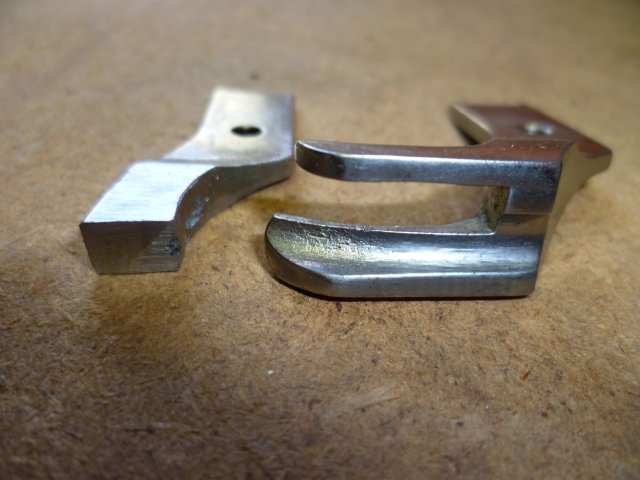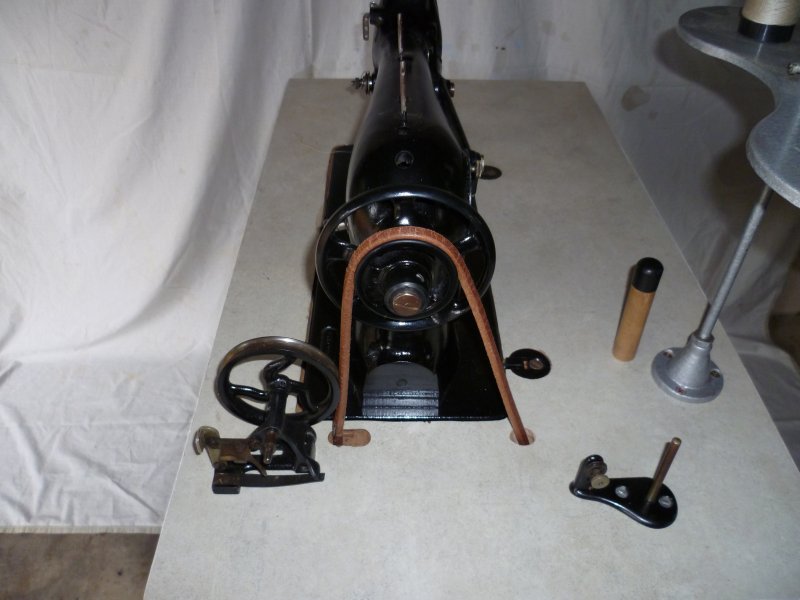-
Posts
4,810 -
Joined
-
Last visited
Content Type
Profiles
Forums
Events
Blogs
Gallery
Everything posted by dikman
-

Foam press for leather holsters?
dikman replied to SouthernCross's topic in Gun Holsters, Rifle Slings and Knife Sheathes
Quite a contraption, Brian! Of course, for leather work it can be made a lot simpler as no heating elements are required. I use a compressor head for getting a vacuum, I just hook the chamber up to the inlet side of the compressor head, has no trouble pulling 28" of vacuum. -
I thought the same thing. A MAPP torch and some silver solder from Bunnings plumbing section should do it.
-
For what it's worth , I have some braided thread that is ex-factory, used for shoe/bootmaking, and I cannot get it to sew reliably with any of my machines. The braiding always seems to snag somewhere at some point. Pity, it's really nice thread. Your list of things that you want to sew is fine for probably most "medium" machines that are commonly used here - except for holsters! They require a heavy duty machine. If you look at the list of machines that I have they're probably amongst the most common types, but none of them can do holsters (unfortunately). Holsters I still sew by hand.
-
Great deal! At that price it's worth chucking the clutch out and investing in a servo. As Uwe said, try without a speed reducer first. I've found a 2" pulley on the motor and fitting a larger pulley (8") in place of the handwheel works well without messing around with a speed reducer (did this on my Pfaff and Seiko). Just saw your post. Although there may be differences, the manual should be fine for getting the basic adjustments and servicing needed on yours.
-
Two thinner pieces stacked together? (No idea if it would work). If you have a belt grinder then a slightly thicker one can be thinned down (common practice with firearm springs) although it might take a while with a bigger spring. Sometimes they reduce the sides of the spring, rather than the thickness, by making it an "hourglass" shape. Just trying to come up with a few possibilities.
-

Dürkopp 18 Patcher Restoration - long journey...
dikman replied to Constabulary's topic in Leather Sewing Machines
The stand looks great! Good start. -
It can take quite a while to get your head around how industrial machines work, some of the adjustments only have to be out a smidgin to cause problems and it's sometimes tricky to figure out just which adjustment is out. As you get used to the various adjustments it becomes easier troubleshooting them - but it takes time and hands-on fiddling to reach that stage. After all the messing around I've done with my machines I can still get it wrong! A little while ago I made a gunbelt for someone and started running the stitching around the edge. I got halfway and thought it looked pretty good - until I flipped it over, it was a mass of loops!!! I had to cut out all the stitches and re-do it.Seems I'd somehow forgotten to set the upper thread tension (still can't figure out how it happened). Those Singers, by the way, are great machines.
-

Inline Cowboy presser feet on Cowboy CB4500
dikman replied to Wizcrafts's topic in Leather Sewing Machines
No doubt about it, Uwe, you do some nice work! Constabulary, the bluing worked, just thought you might like to know. Not quite up to Uwe's standard, but, hey, the leather won't care . -

Delivered one today
dikman replied to Dwight's topic in Gun Holsters, Rifle Slings and Knife Sheathes
Dwight, that is very nice, quite elegant looking. -

Inline Cowboy presser feet on Cowboy CB4500
dikman replied to Wizcrafts's topic in Leather Sewing Machines
Good idea! I've got some cold bluing solution, I'll give that a try first. -

Inline Cowboy presser feet on Cowboy CB4500
dikman replied to Wizcrafts's topic in Leather Sewing Machines
Ok, Uwe's had me thinking about this, so I figured I'd have a go as it could be a useful addition to my foot collection. I had a spare welting foot that came with some bits with one of my machines (can't remember which one!). As I have two of those feet, and am unlikely to ever use them anyway, I figured I could sacrifice one. I filled in the hollow on the bottom with weld then got stuck in to it on the belt grinder. Took a bit of trial-and-error but I ended up with a working foot. It still needs a bit of smoothing down, and the only problem I can see is being plain steel it will rust. Two possible solutions occurred to me - coat it with Devcon epoxy or Parkerize it (more messing around but probably the best solution). -
Obviously good design right from the start!
-
Drawer? Mine goes well beyond a "drawer"!
-
No worries, glad I could contribute something useful. I figure the post on the front part of mine is for small spools.
-
Nice bit of fettling. As an aside, my 31K20 came with the winder in two parts, I assume you have the other bit to feed the thread?
-
I'm not sure how you'll go with a small cylinder arm that can handle heavy thread, hopefully others with more experience can provide suitable models to look for. I think the 227r can handle up to 207, but my Pfaff 335 can only handle up to 138.
- 22 replies
-
If you can find a larger pulley to replace the handwheel you'll slow it down even more.
-
One of the advantages of a walking foot is no slippage of layers if using multiple layers, with a roller foot you could get slipping/bunching. I've also found that it's fairly easy to get needle deflection and breaking (not nice!) when using a roller foot if the leather is too thick or moves in any way while sewing. As for seeing the needle where it enters the leather, yep, I know what you mean. I bought an inner foot that is slotted so I can see where I'm sewing, not perfect but acceptable.
- 22 replies
-
Nice buy, and looks to be in remarkably good condition. Like that stool!
-
I have a 201K (similar, just a little bit later model) with the original Singer handcrank. It takes a bit of effort to get through thicker leather (I would say 4mm/10 oz is the comfortable max.) Plus with that homemade handcrank you have to turn it backwards compared to the Singer (geared) crank. A nice writeup, but a bit over-the-top in my opinion, and way to much money for what it is.
-
Looks good! That original setup would need to be bolted to the floor, I reckon, doesn't look particularly stable to me!!
-

First Mexican loop
dikman replied to Clintock's topic in Gun Holsters, Rifle Slings and Knife Sheathes
Funnily enough, I've found I'm doing the same thing, always studying holsters and belts. -
Wicked, there is a lot to learn about industrial sewing machines, particularly relating to leather use. Just keep reading, it took me quite a while to start coming to grips with the subject. For what you want to do any of the "old standbys" should be more than adequate - Juki 562/563, Consew 206, Singer 111W153/154/155, Singer 211G165/166, Seiko STH-BLD, all are pretty similar in operation and capability. Or a Pfaff 335 cylinder arm. These machines are all "oldies but goodies".
-

7 weeks off and had this to build
dikman replied to OLDNSLOW's topic in Gun Holsters, Rifle Slings and Knife Sheathes
Fish-scale pattern? Makes a change from basketweave.

.jpg.d60258221c476480a6e073a8805645bb.jpg)



